You Know, I Think The Biggest Disappointment Of My Childhood Was Not Failing To Receive My Hogwart’s
You know, I think the biggest disappointment of my childhood was not failing to receive my Hogwart’s letter (or the American equivalent). I mean yes, there was a stretch the summer I was eleven where I was hopeful, but September first came around and I sort of shrugged and accepted it (possibly with some relief because I didn’t want to go so far away from Mama and Da).
No. The real disappointment was that the Wizard’s Oath from Diane Duane’s Young Wizards never took. I don’t know how many times I read that oath out loud and then held my breath and hoped. Hoped, hoped, hoped that I would wake up the next morning and the book wouldn’t just be Nita and Kit’s adventure, but would be in the Speech. It never was.
Keep reading
More Posts from Outofambit and Others

A remarkable new study on how whales behaved when attacked by humans in the 19th century has implications for the way they react to changes wreaked by humans in the 21st century. The paper, published by the Royal Society on Wednesday [17 March 2021], is authored by Hal Whitehead and Luke Rendell, pre-eminent scientists working with cetaceans, and Tim D Smith, a data scientist, and their research addresses an age-old question: if whales are so smart, why did they hang around to be killed? The answer? They didn’t. Using newly digitised logbooks detailing the hunting of sperm whales in the north Pacific, the authors discovered that within just a few years, the strike rate of the whalers’ harpoons fell by 58%. […] Before humans, orca were their only predators […]. It was a frighteningly rapid killing, and it accompanied other threats to the ironically named Pacific. From whaling and sealing stations to missionary bases, western culture was imported to an ocean that had remained largely untouched […].
——-
Headline and text published by: Philip Hoare. “Sperm whales in the 19th century shared ship attack information.” The Guardian. 17 March 2021.


Catching a sperm whale during the 19th century was much harder than even Moby Dick showed it to be. That’s because sperm whales weren’t just capable of learning the best ways to evade the whalers’ ships, they could quickly share this information with other whales, too, according to a study of whale-hunting records. […]
“At first, the whales reacted to the new threat of human hunters in exactly the same way as they would to the killer whale, which was their only predator at this time,” study lead author Hal Whitehead, a professor of biology at Dalhousie University in Nova Scotia, told Live Science. “[The sperm whales] all gathered together on the surface, put the baby in the middle, and tried to defend by biting or slapping their tails down. But when it comes to fending off Captain Ahab that’s the very worst thing they could do, they made themselves a very large target.”
The whales seem to have learned from their mistakes, and the ones that survived quickly adapted — instead of resorting to old tactics, the whalers wrote in their logbooks, the sperm whales instead chose new ones, swimming fast upwind away from the whalers’ wind-powered vessels. […]
The whales communicated with and learned from each other rapidly, and the lessons were soon integrated into their wider culture across the region, according to the researchers’ interpretation of the data.
“Each whale group that you meet at sea typically comprises two or three family units, and the units quite often split off and form other groups,” Whitehead said. “So, what we think happened is that one or two of the units that make up the group could have had encounters with humans before, and the ones who didn’t copied closely from their pals who had.“
Sperm whales are excellent intel sharers: Their highly observant, communicative nature, and the fact that each family unit only stays in larger groups for a few days at a time, means they can transmit information fast.
As studies show, that information could be news on new threats, new ways to hunt or new songs to sing.
——-
One example of whales’ extraordinary information sharing abilities involves lobtail feeding, in which a humpback whale slaps its tail hard against the water’s surface, submerges to blow disorienting bubbles around its prey, and then scoops the prey up in its mouth. Researchers first observed this tactic being used by a single whale in Cape Cod, Massachusetts, in 1980, before it spread throughout the regional population in just 10 years.
Whale culture also extends far deeper than innovative ways to feed. “Sperm whales are divided into acoustic cultural climates,” Whitehead said. “They split themselves into large clans, each with distinctive patterns of sonar clicks, like a dialect, and they only form groups with members of the same clan.”
Different whale clans each have different ways of singing, moving, hunting and looking after their calves. These differences are profound enough to even give some clans a survival advantage during El Nino events, according to Whitehead. […]
In the 20th century, whales, especially the 13 species belonging to the category of ‘great whales’ — such as blue whales, sperm whales and humpback whales — found themselves pursued by steamships and grenade harpoons that they could not escape. These whales’ numbers plummeted and they soon faced extinction. […] [T]hey still face the growing destabilization of their habitats brought about by industrial fishing, noise pollution and climate change.
——-
Headline, image, caption, and text published by: Ben Turner. “Sperm whales outwitted 19th-century whalers by sharing evasive tactics.” Live Science. 19 March 2021.


Kepler Mission Analysis Shows Reduced Number of Earth-Sized Planets in Field of View
A large number of worlds found by NASA’s Kepler alien planet-hunting space telescope are probably significantly larger than scientists previously estimated, a new study suggests. Using a galaxy similar to our own Milky Way, the image above shows the scale of the distances for the sample of stars with planet candidates described in a new study by scientists using the Kitt Peak National Observatory Mayall 4-meter telescope . The circled dot represents the position of the sun in the Milky Way, and the stippled cone shows how far away the new candidate stars are (2800-7000 light years), compared to the size of our galaxy.
The Kepler Space Telescope has spotted more than 2,700 potential exoplanets since its launch in 2009, and scientists using the Kitt Peak National Observatory categorized the home stars of many of those planet candidates for the past three years. In particular, the researchers made detailed follow-up observations of 300 of the stars Kepler found likely to be harboring exoplanets.
The Kepler satellite, in orbit around the sun, stares at a region of the northern hemisphere sky sandwiched between the bright stars Vega and Deneb. Attached to the telescope is the largest imaging camera ever flown into space—16 million pixels—the only instrument on the telescope and the one used to monitor all the stars in its search for planets. Planets are detected if they pass in front of their parent sun, causing a very slight dip in the star’s brightness. When this dip repeats periodically, it reveals the presence of a possible planet, the length of the planet’s “year”, and other information.
One of the main findings of this initial work is that our observations indicate that most of the stars we observed are slightly larger than previously thought and one quarter of them are at least 35 percent larger,” astronomer and leader of the study Mark Everett said in a statement. “Therefore, any planets orbiting these stars must be larger and hotter as well. By implication, these new results reduce the number of candidate Earth-size planet analogues detected by Kepler.”
Read
Ocean Ramsey and her team encountered this 20 ft Great White Shark near the island of Oahu, Hawaii. It is believed to be the biggest ever recorded

Cosmic Dance: Creation of Supermassive Black Holes
Evolution of two equal sized galaxies colliding and forming a massive cloud of gas that will collapse into black hole.
Credit: Ohio State University

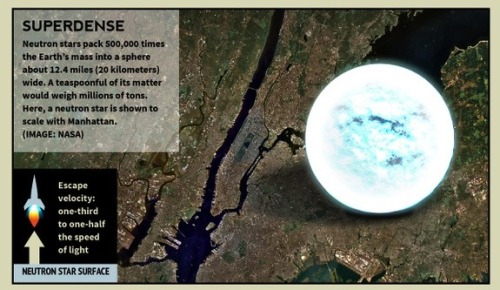
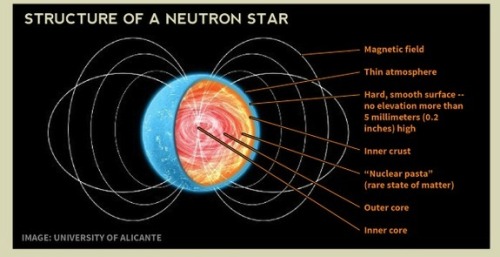
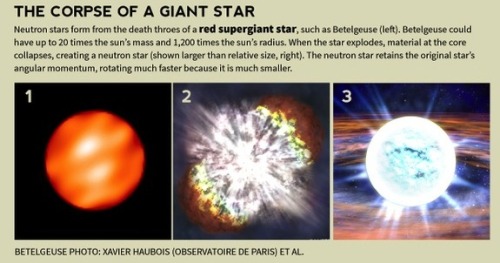
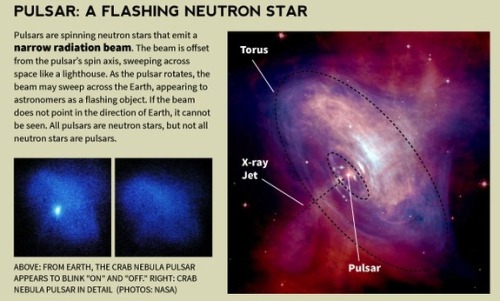

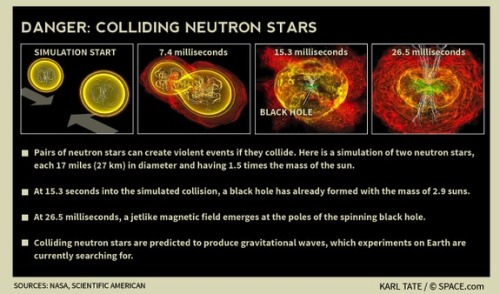
Inside a Neutron Star
Credit: Karl Tate, via SPACE.com

Scale of Universe Measured with 1-Percent Accuracy
An ultraprecise new galaxy map is shedding light on the properties of dark energy, the mysterious force thought to be responsible for the universe’s accelerating expansion.
Image: An artist’s concept of the latest, highly accurate measurement of the universe from the Baryon Oscillation Spectroscopic Survey. The spheres show the current size of the “baryon acoustic oscillations” (BAOs) from the early universe, which have helped to set the distribution of galaxies that we see in the universe today. BAOs can be used as a “standard ruler” (white line) to measure the distances to all the galaxies in the universe. Credit: Zosia Rostomian, Lawrence Berkeley National Laboratory
A team of researchers working with the Baryon Oscillation Spectroscopic Survey (BOSS) has determined the distances to galaxies more than 6 billion light-years away to within 1 percent accuracy — an unprecedented measurement.
"There are not many things in our daily lives that we know to 1-percent accuracy," David Schlegel, a physicist at Lawrence Berkeley National Laboratory and the principal investigator of BOSS, said in a statement. "I now know the size of the universe better than I know the size of my house."
At least once Nita makes it to college she won’t have to keep asking her dad or counselor to cover for her when she has to miss school. If one of my students emailed me saying they were going to miss class because they had to stop the universe from tearing itself apart I’d be like ‘cheers I’ll drink to that bro’

Russian shorthand. 19th c.
8tracks is Radio, rediscovered - blood in the water i sing; (38min) by maerad| music tags: young wizards, deep wizardry, and the song of twelve | a mix for the song of twelve.
awesome playlist for deep wizardry. listen, cousins!
IM NOT FLAILING ARE YOU FLAILING!?!?
DD's ten favorite lines from "Games Wizards Play"
10: “I’d prefer it to rain chocolate frosted donuts in my kitchen on Sunday mornings, but I don’t seem to be getting a lot of that.”
9: “Look, we’re all in The Sims.”
8: “But I’m on your side this time.”
7: “Wizardry is mean to me. I’m gonna tell.”
6: “Just don’t blame me if now she lives long enough to reproduce.”
5: “We’re using such different dictionaries.”
4: “It can probably be seen from space, but don’t let that bother you.”
3: “You may continue to stand in my presence.”
2: "That worked.”
1: "It made my day."
-
 buurenaar liked this · 4 years ago
buurenaar liked this · 4 years ago -
 a-cup-of-fantasy liked this · 6 years ago
a-cup-of-fantasy liked this · 6 years ago -
 twister-girl-blog liked this · 6 years ago
twister-girl-blog liked this · 6 years ago -
 khordreblogs reblogged this · 6 years ago
khordreblogs reblogged this · 6 years ago -
 ddpej liked this · 6 years ago
ddpej liked this · 6 years ago -
 andwereallwevegot liked this · 6 years ago
andwereallwevegot liked this · 6 years ago -
 dubiousculturalartifact liked this · 6 years ago
dubiousculturalartifact liked this · 6 years ago -
 jazzhandsmcleg liked this · 6 years ago
jazzhandsmcleg liked this · 6 years ago -
 ignisraven reblogged this · 6 years ago
ignisraven reblogged this · 6 years ago -
 fandom-princ3 reblogged this · 7 years ago
fandom-princ3 reblogged this · 7 years ago -
 necer0s reblogged this · 7 years ago
necer0s reblogged this · 7 years ago -
 kingofbackpain liked this · 8 years ago
kingofbackpain liked this · 8 years ago -
 kaikama liked this · 8 years ago
kaikama liked this · 8 years ago -
 cambriancrew liked this · 8 years ago
cambriancrew liked this · 8 years ago -
 ssockie reblogged this · 8 years ago
ssockie reblogged this · 8 years ago -
 somadyoucouldbite liked this · 8 years ago
somadyoucouldbite liked this · 8 years ago -
 ssockie liked this · 8 years ago
ssockie liked this · 8 years ago -
 necer0s liked this · 8 years ago
necer0s liked this · 8 years ago -
 stop-that-llama liked this · 8 years ago
stop-that-llama liked this · 8 years ago -
 riftbard liked this · 8 years ago
riftbard liked this · 8 years ago -
 onionowlwatchingu liked this · 8 years ago
onionowlwatchingu liked this · 8 years ago -
 tobyszieglers liked this · 8 years ago
tobyszieglers liked this · 8 years ago -
 searchingforserendipity25 reblogged this · 8 years ago
searchingforserendipity25 reblogged this · 8 years ago -
 searchingforserendipity25 liked this · 8 years ago
searchingforserendipity25 liked this · 8 years ago -
 separateentity liked this · 8 years ago
separateentity liked this · 8 years ago -
 in-mutual-weirdness liked this · 9 years ago
in-mutual-weirdness liked this · 9 years ago -
 herc18 liked this · 9 years ago
herc18 liked this · 9 years ago -
 sabrinix liked this · 9 years ago
sabrinix liked this · 9 years ago -
 cheshire-alice liked this · 9 years ago
cheshire-alice liked this · 9 years ago -
 wreck-it-remy-no-more liked this · 9 years ago
wreck-it-remy-no-more liked this · 9 years ago -
 eidorian999 liked this · 9 years ago
eidorian999 liked this · 9 years ago -
 rebeccaphilana reblogged this · 9 years ago
rebeccaphilana reblogged this · 9 years ago -
 soilrockslove liked this · 9 years ago
soilrockslove liked this · 9 years ago -
 space-pikachu reblogged this · 9 years ago
space-pikachu reblogged this · 9 years ago -
 aniseandspearmint liked this · 9 years ago
aniseandspearmint liked this · 9 years ago -
 comeon-intothemadhouse liked this · 9 years ago
comeon-intothemadhouse liked this · 9 years ago -
 shittydiscourse liked this · 9 years ago
shittydiscourse liked this · 9 years ago -
 pseudonymouscherry liked this · 9 years ago
pseudonymouscherry liked this · 9 years ago -
 fail-sage liked this · 9 years ago
fail-sage liked this · 9 years ago -
 skythrown-blog liked this · 9 years ago
skythrown-blog liked this · 9 years ago -
 morhath reblogged this · 9 years ago
morhath reblogged this · 9 years ago -
 inkidink reblogged this · 9 years ago
inkidink reblogged this · 9 years ago -
 inkidink liked this · 9 years ago
inkidink liked this · 9 years ago -
 lushprocrastinatrix liked this · 9 years ago
lushprocrastinatrix liked this · 9 years ago -
 semiotomatics liked this · 9 years ago
semiotomatics liked this · 9 years ago
A personal temporospatial claudication for Young Wizards fandom-related posts and general space nonsense.
288 posts